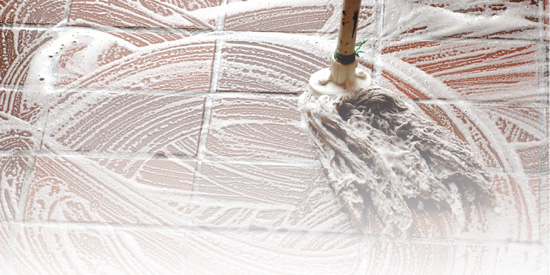
How you care for your floors depends on what they are made of. Some, like shiny, sealed floors, take less effort to keep clean than unsealed ones, while delicate materials, such as wood or laminate, require special attention.
Floors are made to walk on, so naturally they need frequent care to keep them clean and in good condition. Tile, wood and stone floors require special treatment to bring out their characteristic highlights and avoid damage.
A MICROFIBER MOP IS GREAT FOR hard-to-reach corners.
• Sweep or vacuum the floor before mopping it. Mop in a wavy line, without lifting the mop from the floor, starting at one end and moving towards the door. If the floor is very dirty, you may need to change the cleaning water.
• Choose a sponge mop for cleaning tile floors, as they do a much better job of cleaning seams and small irregularities in the tiles. For extra stubborn dirt, use a scrubbing brush and wash the tiles by hand—sometimes there is no substitute for elbow grease.
• Clean stone floors by adding a small amount of ammonia to the water. This combination also makes dull tile floors shine like new.
• Seal porous terra-cotta and unglazed natural stone tiles with linseed oil as soon as they have been laid (before grouting), and avoid mopping for 2 weeks. You can use this type of waterproofing for areas that are subject to heavy use, such as doorways and the kitchen.
• Remove liquid stains (such as tea, coffee, cola, red wine, fruit juices and ink) from porous tiles by dabbing them with a little regular stain remover, available from supermarkets or hardware stores.
• Make sure as little moisture as possible is left behind by a wet mop, as this will cause wood floors to swell and warp. Beware of using extremely hot water as it may cause the wood to crack and split.
• Tackle serious stains and streaks on sealed wood floors by adding a shot of ammonia to the water.
• Sweep up sand and small stones at once, as they are abrasive and could scratch and cause damage.
• Remove scratches in a wood floor with a little homemade shoe polish (see box, below).
• Mop sealed wood floors with black tea to add a matte sheen and an attractive color.
• Avoid waxing floors too often. The trick is to add 4 tablespoons (60 ml) furniture polish and 1 cup (250 ml) white vinegar to mop water occasionally.
• Scrub oiled wood floors with a warm soda solution—3 tablespoons (45 ml) baking soda in 1 quart (1 L) warm water—then mop with tap water. Repeat until the solution is mopped up and floors are clear. Occasionally recoat the floor with a thin layer of linseed oil.
• Carefully scrape off ground-in dirt with a knife, working in the direction of the wood grain. Lightly rub the area with a dab of mineral spirits before washing and polishing with a soft cloth.
Removing scratches from wood
one Rub out scratches with a mixture of equal parts lemon juice and olive oil, applied on a soft, lint-free cloth.
two Rub in some furniture wax, or mix a little medium-brown shoe polish with basic floor polish.
three Rub the mixture into the wood until the color matches the floor.
• Sweep and damp mop laminated floors. Too much moisture will make the material swell.
• Damp mop sealed cork flooring then rub dry. Apply wax sparingly twice a year and occasionally polish until shiny. You don’t have to dry cork flooring that is vinyl coated.
• You can best protect a stone floor by applying a cement sealer and wax. Clean slate and stone flooring with water and a sparing amount of household cleaner, but be careful–if you use too much cleaner it can remove the color. After mopping and drying, apply some lemon oil to make the floor shine like new. Remove any excess oil with a dry rag.
• Wash polished limestone flooring with a low-pH all-purpose cleaner or it will become dull. Use a cleaner with as little detergent as possible (10–20 percent) and no more than 4 percent phosphate, as both are not biodegradable.
• Do not use vinegar for cleaning or washing natural stone floors, such as marble or limestone. They can dissolve when exposed to acidic cleaners.
• Remove stubborn marks from vinyl floors by rubbing with kerosene and superfine steel wool. Then wash with warm, soapy water, rinse and mop dry.
• Remove scuff marks and dirt from baseboards covered with polyurethane or oil-based paint with a sponge and a grease-cutting, all-purpose dishwashing liquid then wipe with a cloth dampened with water. You can also use a household spray cleaner–spray on a clean cloth, not the baseboard, to prevent streaking and avoid getting it on the floor.
• If you find really tough stains on the baseboard, test an inconspicuous corner with scouring powder on an all-purpose, plastic scrubbing pad. If the test does not cause any damage, apply the method to the entire baseboard.